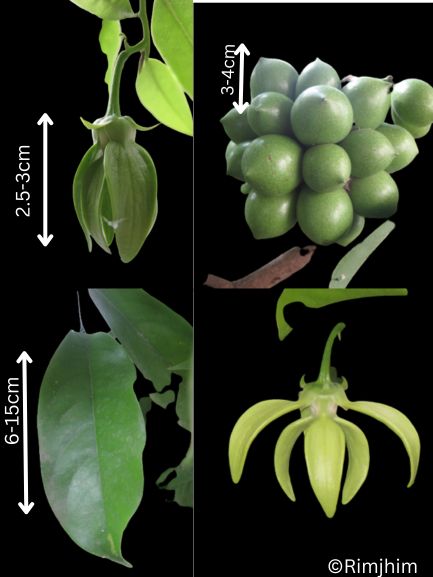Botanical name: Artabotrys hexapetalus
Family: Annonaceae (sugar apple family)
Manoranjitham, the climbing ylang-ylang, is a shrub found in India through to Burma, southern China and Taiwan, having flowers that are renowned for their exotic fragrance.n It is also called ylang-ylang vine or tail grape in English, with various names in other languages. The yellow-coloured flowers of this plant are very fragrant. The flowers are greenish in the beginning and turn yellow with age and the flowers are long-lasting with a fruity pleasant smell. When young it is a shrub that turns into a climber once attains a height of about 2 meters.
Also known by its common name in India as “Manorangini”, Hari Champa has an intoxicating fragrance! This species is native to India and tropical Asia. A medium size climbing shrub 8-10 ft, producing flowers that are greenish and fade to yellow with age, and are extremely fragrant. Once picked they are very long-lasting and hold their scent for days, if kept in water, permeating an entire room. Flowers have three outer and three inner greenish-yellow petals – hence the name hexapetalus. It is a fruity sweet smell – the Manipuri name Chini Champra, meaning sugar lemon, is indicative of that. Narrowly elliptical leaves, 6-15 cm long, 2-4.5 cm wide, are usually 3-4 times as long as wide, acute or almost so at the base, short-acuminate at the tip, not glossy. Lateral veins are 8-16 pairs. Fruits are 3-4 cm long when ripe, oval and smooth. When young, this climber grows just like a regular shrub but at 5-6 ft, will start to vine. It is not an aggressive vine.
Location: Kangra, Himachal Pradesh, India.
Photograph Clicked on 21 June 2020.
References:
Hari Champa, Flowers of India, http://www.flowersofindia.net/catalog/slides/Hari%20Champa.html.
Artabotrys hexapetalus, Wikipedia, https://en.wikipedia.org/wiki/Artabotrys_hexapetalus

Leave a Reply